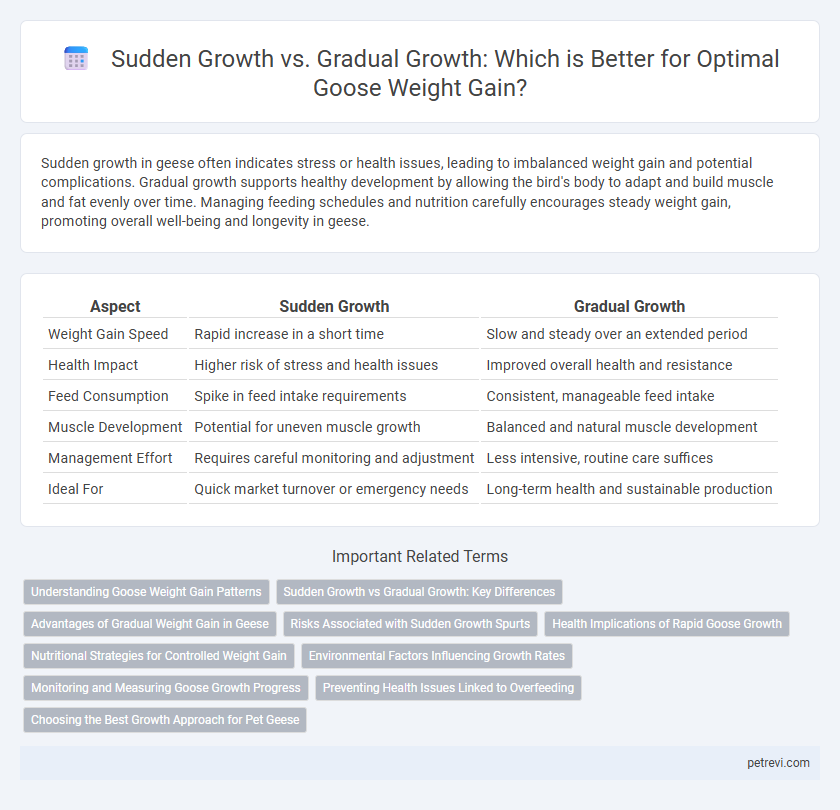Sudden growth in geese often indicates stress or health issues, leading to imbalanced weight gain and potential complications. Gradual growth supports healthy development by allowing the bird's body to adapt and build muscle and fat evenly over time. Managing feeding schedules and nutrition carefully encourages steady weight gain, promoting overall well-being and longevity in geese.
Table of Comparison
| Aspect | Sudden Growth | Gradual Growth |
|---|---|---|
| Weight Gain Speed | Rapid increase in a short time | Slow and steady over an extended period |
| Health Impact | Higher risk of stress and health issues | Improved overall health and resistance |
| Feed Consumption | Spike in feed intake requirements | Consistent, manageable feed intake |
| Muscle Development | Potential for uneven muscle growth | Balanced and natural muscle development |
| Management Effort | Requires careful monitoring and adjustment | Less intensive, routine care suffices |
| Ideal For | Quick market turnover or emergency needs | Long-term health and sustainable production |
Understanding Goose Weight Gain Patterns
Goose weight gain patterns vary significantly between sudden growth and gradual growth phases, with sudden growth often linked to hormonal changes during molting or breeding seasons. Gradual growth typically results from consistent nutrition and optimal environmental conditions supporting steady muscle and fat accumulation. Monitoring feed intake, activity levels, and physiological changes helps optimize feeding strategies tailored to these weight gain patterns for improved health and productivity.
Sudden Growth vs Gradual Growth: Key Differences
Sudden growth in geese typically causes rapid weight gain but may lead to health issues such as joint stress and metabolic disorders, while gradual growth supports steady weight increase and overall well-being. Sudden growth is often linked to high-energy diets or forced feeding practices, whereas gradual growth results from balanced nutrition and natural foraging behavior. Monitoring growth patterns helps optimize feeding strategies and ensures healthier, more sustainable weight gain in geese.
Advantages of Gradual Weight Gain in Geese
Gradual weight gain in geese promotes steady muscle development and reduces the risk of metabolic disorders associated with sudden growth. This consistent increase supports healthier bone density and improves overall immune function, leading to enhanced longevity and productivity. Additionally, slow weight gain ensures better feed efficiency, optimizing nutrient absorption without overwhelming the digestive system.
Risks Associated with Sudden Growth Spurts
Sudden growth spurts in goose weight gain often lead to increased risks such as leg deformities, cardiovascular strain, and metabolic disorders due to rapid tissue development outpacing skeletal strength. Gradual growth supports balanced musculoskeletal development and reduces the incidence of developmental diseases like tibial dyschondroplasia. Monitoring feed intake and adjusting nutrient density can help mitigate health complications arising from abrupt weight increases in young geese.
Health Implications of Rapid Goose Growth
Sudden growth in geese often leads to increased risks of skeletal deformities and cardiovascular stress due to the body's inability to adapt quickly to rapid weight gain. Gradual growth supports balanced development, promoting stronger bone density and improved overall health, reducing mortality rates associated with abrupt size changes. Managing feed and environment to encourage steady weight gain is essential for maintaining optimal physiological function and long-term welfare in geese.
Nutritional Strategies for Controlled Weight Gain
Sudden growth in geese often leads to imbalanced muscle development and fatty deposits, increasing the risk of metabolic disorders, while gradual growth ensures steady weight gain aligned with skeletal maturity. Nutritional strategies for controlled weight gain emphasize balanced protein levels, adequate energy sources, and essential vitamins and minerals to support healthy tissue development and metabolic functions. Implementing phased feeding programs with precise nutrient formulations optimizes growth rates, reduces stress on the digestive system, and promotes overall health in geese.
Environmental Factors Influencing Growth Rates
Goose weight gain is significantly influenced by environmental factors such as temperature, nutrition quality, and housing conditions, which can accelerate sudden growth phases or support gradual development. Sudden growth often occurs in optimal conditions with abundant high-protein feed and stable warm environments, whereas gradual growth aligns with fluctuating temperatures and less nutrient-dense diets. Light exposure duration and space availability also play critical roles, impacting metabolic rates and physical activity that determine the growth trajectory of geese.
Monitoring and Measuring Goose Growth Progress
Monitoring goose weight gain involves precise measurement methods such as weekly weighing to distinguish sudden growth from gradual growth patterns. Sudden growth may indicate health or environmental changes, requiring closer observation to prevent issues like leg weakness, while gradual growth aligns with standard feeding and developmental benchmarks. Tracking weight against age-specific growth charts ensures accurate assessment of progress and timely adjustments in nutrition or care.
Preventing Health Issues Linked to Overfeeding
Rapid weight gain in geese often leads to metabolic disorders, joint stress, and fatty liver disease, emphasizing the importance of controlled feeding. Gradual growth through balanced nutrition and portion control minimizes the risk of obesity-related health problems and promotes long-term well-being. Implementing a feeding regimen that avoids sudden overfeeding supports optimal weight management and reduces the incidence of health complications in geese.
Choosing the Best Growth Approach for Pet Geese
Sudden growth in pet geese can lead to health issues such as joint problems and metabolic stress, making gradual growth the preferred approach for sustainable weight gain. Gradual growth ensures balanced development, improved immune function, and reduces the risk of obesity-related complications in geese. Prioritizing a consistent, nutrient-rich diet aligned with the natural growth rates optimizes long-term wellness and vitality in pet geese.
Sudden Growth vs Gradual Growth for Goose Weight Gain Infographic

 petrevi.com
petrevi.com